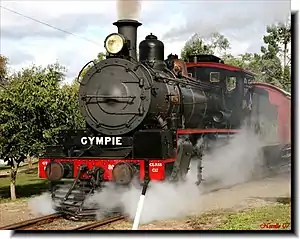Queensland C17 class locomotive
The Queensland Railways C17 class locomotive was a class of 4-8-0 steam locomotives operated by the Queensland Railways.
| Queensland Railways C17 class | |||||||||||||||||||||||||
|---|---|---|---|---|---|---|---|---|---|---|---|---|---|---|---|---|---|---|---|---|---|---|---|---|---|
 802 on the Mary Valley Heritage Railway | |||||||||||||||||||||||||
| |||||||||||||||||||||||||
| |||||||||||||||||||||||||
| |||||||||||||||||||||||||
| |||||||||||||||||||||||||
History
The C17 class was introduced as an improved version of the C16 class. Per Queensland Railway's classification system they were designated the C17 class, C representing they had four driving axles, and 17 representing the cylinder diameter in inches.
The design was so successful that 227 locomotives were built from 1920 when the first engine Nº 15 entering service through until 1953 when Nº 1000 was delivered. The Commonwealth Railways NM class were of the same design.[1][2][3][4]
They were used to haul Mail trains on lines could not accommodate heavier B18¼ class, also suburban passenger, mixed, goods and branch line trains. Until 1948 they were the heaviest engines that could work north of Mackay. Prior to the introduction of 60 long tons (67 short tons; 61 t) diesel electric locomotives, they were responsible for hauling the air-conditioned Inlander, Midlander and Westlander trains for parts of their respective journeys.
First engines had large steam domes, open cabs and C16 style tenders. Those built from 1938 onwards, commencing with N°858, had small steam domes, sedan cabs with welded tenders and also larger diameter (9+1⁄2 in or 241 mm) piston valves. The two types of boilers were occasionally interchanged at overhauls and by later years most of the old style ones had been replaced. The last 40 engines, Nº961 to Nº1000, were fitted with Timken roller bearings and painted brown. They acquired the nickname of Brown Bombers after American boxer Joe Louis. Those overhauled in the last years of steam operations were repainted black. A number of modifications were carried out over their life including the fitting of large mushroom air snifting valves. Several had additional sandboxes and/or rear headlights fitted at various times for working lines where no turning facilities were available.[1][3]
On 5 May 1947, C17 class locomotive 824 left the rails near Camp Mountain on the Dayboro line claiming the lives of 16 people and 38 injured. The Commonwealth Department of Trade & Customs Recreation and Social Club had chartered the train for a picnic at Closeburn. Negotiating a sharp curve at excessive speed caused the tragedy. The locomotive was repaired and continued in service until May 1967 when it was transferred to Injune along the recently closed line.
Preservation
Twenty-five have been preserved:
- 2 at the North Ipswich Railway Workshops[5]
- 45 at Mary Valley Rattler[6]
- 251 plinthed in Townsville[7]
- 253 at Mary Valley Rattler[8]
- 705 at Mary Valley Rattler, loaned to the Imbil Progress Association for display [9]
- 720 at the Australian Railway Historical Society[10][11]
- 721 plinthed in Jandowae as 719 [12]
- 761 currently undergoing overhaul at QPSR[13]
- 763 at the Australian Railway Historical Society[14]
- 802 at Downs Explorer[15]
- 809 plinthed in Injune[16]
- 812 at Downs Explorer[17]
- 819 at Mary Valley Rattler[18]
- 824 plinthed in Injune[19]
- 934 at Zig Zag Railway[20]
- 935 at Downs Explorer [21]
- 944 at the Miles Historical Village and Museum[22]
- 965 plinthed in Mundubbera[23]
- 966 at Zig Zag Railway[24]
- 967 at Mary Valley Rattler - operational[25]
- 971 at Downs Explorer - undergoing restoration[26][27]
- 974 at the Queensland Rail Heritage Division - undergoing maintenance[28]
- 980 by the Blackwater Lions Club[29]
- 988 at Archer Park Station & Steam Tram Museum, Rockhampton[30]
- 996 at Mary Valley Rattler[31]
- 1000 Queensland Rail Heritage Division, stored at the Workshops Rail Museum[32]
References
- Armstrong, John (1994). Locomotives in the Tropics Volume 2. Brisbane: Australian Railway Historical Society. pp. 57–63. ISBN 9780909937263.
- Turner, Jim (1997). Australian Steam Locomotives 1896-1958. Kenthurst: Kangaroo Press. pp. 77, 146. ISBN 086417778X.
- Oberg, Leon (2010). Locomotives of Australia 1850s-2010. Dural: Rosenberg Publishing. pp. 172–174. ISBN 9781921719011.
- Clark, Peter (2012). An Australian Locomotive Guide. Rosenberg Publishing. p. 69. ISBN 9781921719554.
- C17 No 2 Australian Steam
- C17 No 45 Australian Steam
- C17 No 251 Australian Steam
- No 253 Australian Steam
- No 705 Australian Steam
- No 720 Australian Steam
- Restoration of C17 720 Australian Railway Historical Society
- "Preserved Steam Locomotives Down Under - C17 No.719". www.australiansteam.com. Retrieved 10 July 2022.
- No 761 Australian Steam
- No 763 Australian Steam
- No 802 Australian Steam
- No 809 Australian Steam
- No 812 Australian Steam
- No 819 Australian Steam
- "Preserved Steam Locomotives Down Under - C17 No. 809". www.australiansteam.com. Retrieved 10 July 2022.
- No 934 Australian Steam
- "Preserved Steam Locomotives Down Under - C17 No. 935". www.australiansteam.com. Retrieved 21 March 2020.
- No 944 Australian Steam
- No 965 Australian Steam
- No 966 Australian Steam
- No 967 Australian Steam
- No 971 Australian Steam
- C17 Steam Locomotive No 971 South Downs Steam Railway
- Brown Bomber: C17 974 Workshops Rail Museum
- No 980 Australian Steam
- No 988 Australian Steam
- No 996 Australian Steam
- No 1000 Australian Steam
External links
![]() Media related to Queensland C17 class locomotives at Wikimedia Commons
Media related to Queensland C17 class locomotives at Wikimedia Commons